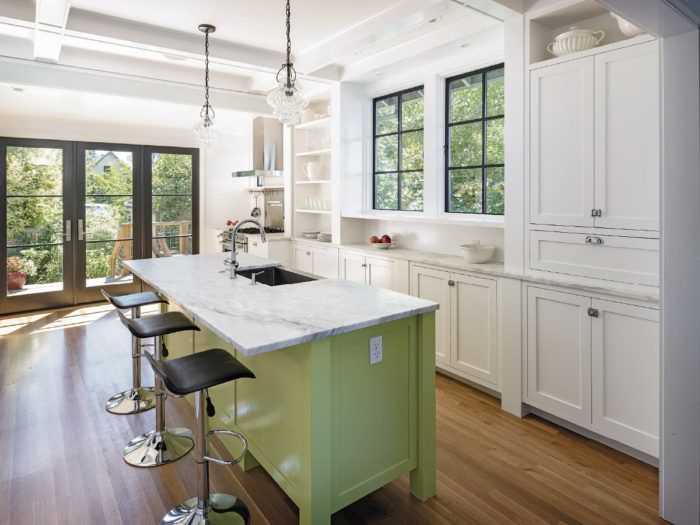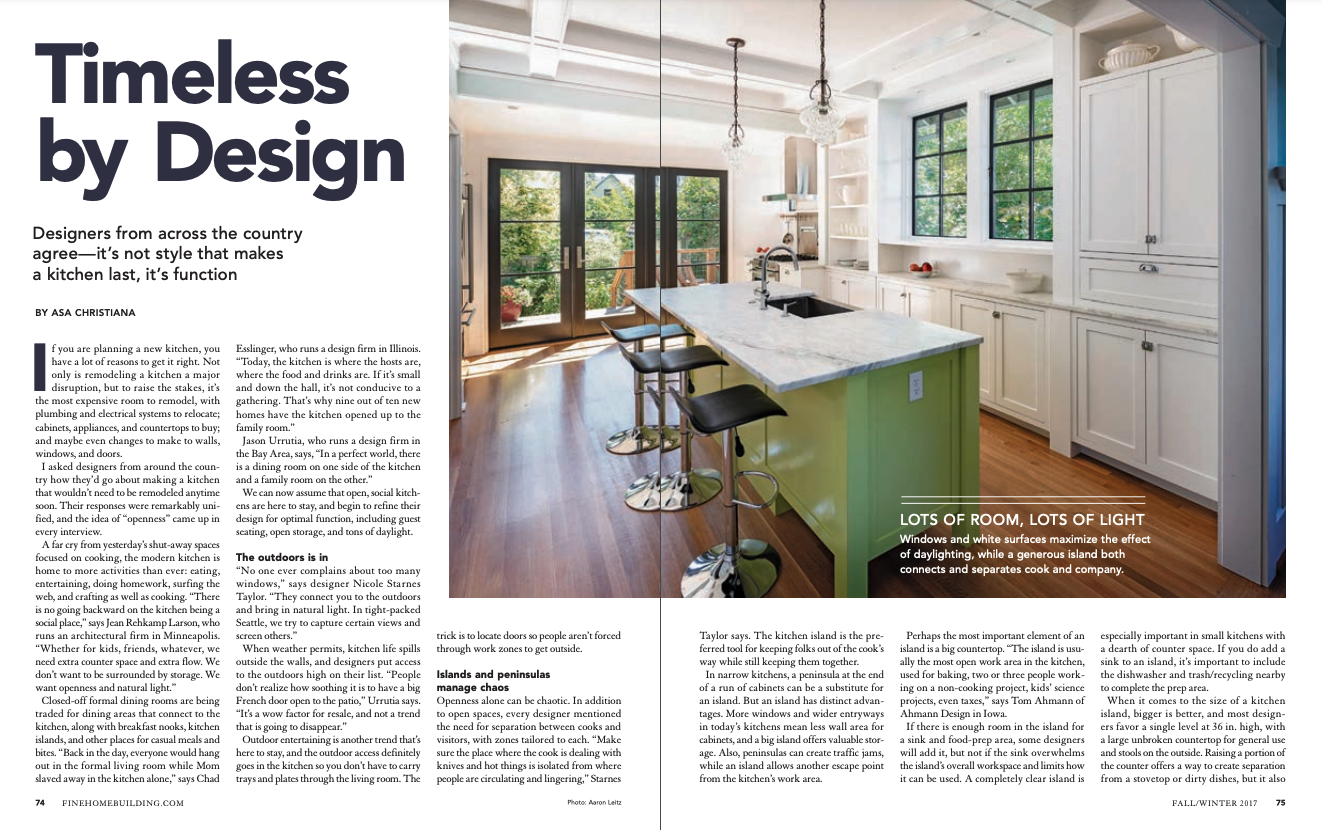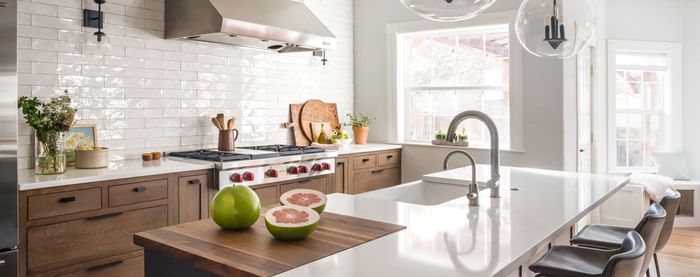When Purposeful Kitchen Design Trumps Style
Designers from across the country agree that it’s not style that makes a kitchen last, it’s function.

If you are planning a new kitchen, you have a lot of reasons to get it right. Not only is remodeling a kitchen a major disruption, but to raise the stakes, it’s the most expensive room to remodel, with plumbing and electrical systems to relocate; cabinets, appliances, and countertops to buy; and maybe even changes to make to walls, windows, and doors.
I asked designers from around the country how they’d go about making a kitchen that wouldn’t need to be remodeled anytime soon. Their responses were remarkably unified, and the idea of “openness” came up in every interview.
A far cry from yesterday’s shut-away spaces focused on cooking, the modern kitchen is home to more activities than ever: eating, entertaining, doing homework, surfing the web, and crafting as well as cooking. “There is no going backward on the kitchen being a social place,” says Jean Rehkamp Larson, who runs an architectural firm in Minneapolis.
“Whether for kids, friends, whatever, we need extra counter space and extra flow. We don’t want to be surrounded by storage. We want openness and natural light.”
Closed-off formal dining rooms are being traded for dining areas that connect to the kitchen, along with breakfast nooks, kitchen islands, and other places for casual meals and bites. “Back in the day, everyone would hang out in the formal living room while Mom slaved away in the kitchen alone,” says Chad Esslinger, who runs a design firm in Illinois. “Today, the kitchen is where the hosts are, where the food and drinks are. If it’s small and down the hall, it’s not conducive to a gathering. That’s why nine out of ten new homes have the kitchen opened up to the family room.”
Jason Urrutia, who runs a design firm in the Bay Area, says, “In a perfect world, there is a dining room on one side of the kitchen and a family room on the other.”
We can now assume that open, social kitchens are here to stay, and begin to refine their design for optimal function, including guest seating, open storage, and tons of daylight.
The outdoors is in
“No one ever complains about too many windows,” says designer Nicole Starnes Taylor. “They connect you to the outdoors and bring in natural light. In tight-packed Seattle, we try to capture certain views and screen others.”
When weather permits, kitchen life spills outside the walls, and designers put access to the outdoors high on their list. “People don’t realize how soothing it is to have a big French door open to the patio,” Urrutia says. “It’s a wow factor for resale, and not a trend that is going to disappear.”
Outdoor entertaining is another trend that’s here to stay, and the outdoor access definitely goes in the kitchen so you don’t have to carry trays and plates through the living room. The trick is to locate doors so people aren’t forced through work zones to get outside.
Islands and peninsulas manage chaos
Openness alone can be chaotic. In addition to open spaces, every designer mentioned the need for separation between cooks and visitors, with zones tailored to each. “Make sure the place where the cook is dealing with knives and hot things is isolated from where people are circulating and lingering,” Starnes Taylor says. The kitchen island is the preferred tool for keeping folks out of the cook’s way while still keeping them together.
In narrow kitchens, a peninsula at the end of a run of cabinets can be a substitute for an island. But an island has distinct advantages. More windows and wider entryways in today’s kitchens mean less wall area for cabinets, and a big island offers valuable storage. Also, peninsulas can create traffic jams, while an island allows another escape point from the kitchen’s work area.
Perhaps the most important element of an island is a big countertop. “The island is usually the most open work area in the kitchen, used for baking, two or three people working on a non-cooking project, kids’ science projects, even taxes,” says Tom Ahmann of Ahmann Design in Iowa.
If there is enough room in the island for a sink and food-prep area, some designers will add it, but not if the sink overwhelms the island’s overall workspace and limits how it can be used. A completely clear island is especially important in small kitchens with a dearth of counter space. If you do add a sink to an island, it’s important to include the dishwasher and trash/recycling nearby to complete the prep area.
When it comes to the size of a kitchen island, bigger is better, and most designers favor a single level at 36 in. high, with a large unbroken countertop for general use and stools on the outside. Raising a portion of the counter offers a way to create separation from a stovetop or dirty dishes, but it also means glasses and plates can fall forward. On the other hand, a section of counter at table height (30 in.) can be added on one side of an island to take the place of a kitchen table, working well for kids and universal access.
Power outlets are critical for charging electronics while people hang out. For lighting, designers prefer pendants over islands and peninsulas to create a focal point and gently encourage people to sit rather than stand.
The triangle shifts
When drawing floor plans, many designers locate the sink first, because people spend the most time there. “My first choice is to tie it to natural light,” Starnes Taylor says. “My second is to put it in the island so the cook can communicate with others without looking over his or her back.” The sink is also the center of the prep zone, meaning that the trash and recycling must be nearby.
In the classic kitchen triangle, the sink, stove, and fridge are all within a stride or two, but that rigid rule has become more relaxed to leave room for multiple cooks and better flow. While the range and sink are inextricably linked, the refrigerator can be an outlier. This approach makes it easier to leave counter and floor space around the fridge, which allows guests to serve themselves drinks without clogging up the cook zone. If it is separate from the cooktop, the oven is another appliance that can be moved outside the cook zone.
No matter where the corners of the triangle end up, designers agree that counter space is essential on both sides of the stove and sink and on at least one side of the fridge and the pantry cabinet if applicable. Wall ovens need landing space too, but a nearby island or peninsula will do in a pinch. For Tamara Herrmann, who handles sales and design for Crown Point Cabinetry in New Hampshire, the rule of thumb is 30 in. of counter on both sides of the range and sink. “We can’t always maintain that in small kitchens,” she says, “but we try to.”
Do more with fewer cabinets
The downside of an open kitchen is fewer cabinets, but designers make no apologies for this. “An open floor plan is more important than storage,” Esslinger says. “Some things can be moved to other parts of the house, like pots and glassware you hardly ever use. How much stuff do you really need?”
In fact, to keep kitchens feeling as open as possible, designers like Starnes Taylor avoid upper cabinets altogether, instead utilizing only windows and one or two floating shelves above the countertops. “I worked in coffee shops, bars, and restaurants, and came to appreciate the efficiency of open shelves,” she says. “Shelves force you to buy nice things that will last a long time, and those things show people who you are and what’s important to you. If you can hide stuff, you tend to accumulate so much more and don’t measure its value. With open shelves, you hold on to what’s useful and functional, what inspires you and makes you happy. Stylistically, it goes back to a farmhouse aesthetic. There is authenticity when tools are displayed, a real connection to what’s happening, like an industrial building where you see the tools.”
Other designers warn that shelves are dust and grease collectors, while upper cabinets offer more storage, as well as a tidier look. Ana Rottkamp, senior designer at Knockout Renovation in New York City, mixes shelves and upper cabinets. “Open shelving is more cost-efficient,” she says, “but we use it in a balanced fashion, on either side of a window, as a place to stack dishes easily, with cabinets around it.”
Every designer spoke out strongly against cabinets that stop short of the ceiling. To minimize cleaning, maximize storage, and create a cleaner look, they run cabinets to the ceiling, or to a soffit for ceilings higher than 8 ft. Full-height uppers employ a two-tier approach in most cases: normal-size cabinets for things used every day, and an upper tier for lesser-used things. “The upper 12 inches can become a display cabinet with glass and lights,” Rottkamp says. “People have to use a stool to get to it, but it is really beautiful.”
Designers are on the same page when it comes to favoring drawers over doors in lower cabinets to make the contents accessible. The ideal is big lower drawers that face upward, their contents at your fingertips.
A pantry is another response to the open kitchen, whether it’s a converted closet or bathroom, or a floor-to-ceiling cabinet with pullout hardware and door racks for storage and to make items more accessible. Some homeowners and designers prefer a walk-in pantry, which offers three walls of supplies.
A popular cousin to the pantry cabinet is a hutch, formed by bringing an upper cabinet down to the countertop, sometimes with small drawers near the bottom. It’s another farmhouse touch that adds character, as well as much-needed storage and organization.
Light highlights design
While some favor an even flood of light and others prefer a targeted array, all designers recommend more light rather than less, and bright, long-lasting LEDs where possible. Like wide doorways and user-friendly cabinets, additional light helps people of all ages and abilities use the kitchen. Today’s best kitchens include task lighting, under-cabinet lighting, above-the-island pendants, and sometimes even lighting at baseboards as night-lights, with separate switches for everything so you can set different moods.
Lighter-colored walls and cabinets also make a kitchen feel brighter and more open. Says Starnes Taylor, “I keep color below the countertop line and white above. It’s a powerful way to make a space seem open. Upper cabinets and bold colors make walls feel like they are closing in, while a dark floor disappears and makes rooms seem more open.”
All designers suggest neutral palettes, asserting that adding the things you use daily, like appliances and colored dishes, plus touches like flowers or art, will add all the pop you need without making a permanent statement you might regret in the future.
Distinctive lights over the island or peninsula create a focal point that is easy to change. Pulls are another place to play. “Take a risk there, follow a trend,” Starnes Taylor says.
“I add a bit of wood to give an earthy feel,” Urrutia says, citing cutting boards, serving boards, and wooden bowls. He notes that open shelves can hold glass canisters with cereal or pasta or rice in them, softening the crispness of the white.
“A nice island idea is all butcher block, or a solid walnut slab,” Esslinger adds. “It gives a farmhouse look in a light-colored kitchen.” Other designers suggest interrupting a long, seamless countertop with a large cutting-board insert.
Create a kitchen that functions well, is a wonderful place to cook and for guests to gather, and which serves as beautiful backdrop for your life, and your kitchen dollars will last for decades.
Asa Christiana writes about woodworking and home design in Portland, Ore.
From Fine Homebuilding #271
To view the entire article, please click the View PDF button below

Fine Homebuilding Recommended Products
Fine Homebuilding receives a commission for items purchased through links on this site, including Amazon Associates and other affiliate advertising programs.

Original Speed Square

Smart String Line

Anchor Bolt Marker





